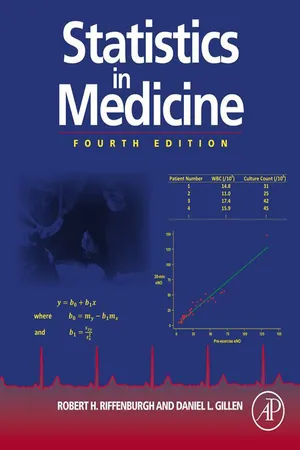
- 822 pages
- English
- ePUB (mobile friendly)
- Available on iOS & Android
Statistics in Medicine
About this book
Statistics in Medicine, Fourth Edition, helps medical and biomedical investigators design and answer questions about analyzing and interpreting data and predicting the sample size required to achieve useful results. It makes medical statistics easy for the non-biostatistician by outlining common methods used in 90% of medical research. The text covers how to plan studies from conception to publication, what to do with data, and follows with step-by-step instructions for biostatistical methods from the simplest levels, to more sophisticated methods now used in medical articles. Examples from almost every medical specialty, and from dentistry, nursing, pharmacy and health care management are provided.This book does not require background knowledge of statistics or mathematics beyond high school algebra and provides abundant clinical examples and exercises to reinforce concepts. It is a valuable source for biomedical researchers, healthcare providers and anyone who conducts research or quality improvement projects.- Expands and revises important topics, such as basic concepts behind descriptive statistics and testing, descriptive statistics in three dimensions, the relationship between statistical testing and confidence intervals, and more- Presents an easy-to-follow format with medical examples, step-by-step methods and check-yourself exercises- Explains statistics for users with little statistical and mathematical background- Encompasses all research development stages, from conceiving a study, planning it in detail, carrying out the methods, putting obtained data in analyzable form, analyzing and interpreting the results, and publishing the study
Frequently asked questions
- Essential is ideal for learners and professionals who enjoy exploring a wide range of subjects. Access the Essential Library with 800,000+ trusted titles and best-sellers across business, personal growth, and the humanities. Includes unlimited reading time and Standard Read Aloud voice.
- Complete: Perfect for advanced learners and researchers needing full, unrestricted access. Unlock 1.4M+ books across hundreds of subjects, including academic and specialized titles. The Complete Plan also includes advanced features like Premium Read Aloud and Research Assistant.
Please note we cannot support devices running on iOS 13 and Android 7 or earlier. Learn more about using the app.
Information
Planning studies: from design to publication
Abstract
Keywords
1.1 Organizing a Study
1.2 Stages of Scientific Investigation
Stages
The causative process is of interest, not the data
1.3 Science Underlying Clinical Decision-Making
The scientific method
Jargon in science
Evidence
Table of contents
- Cover image
- Title page
- Table of Contents
- Copyright
- Dedication
- Maxim
- Foreword to the fourth edition
- Acknowledgments
- How to use this book?
- 1. Planning studies: from design to publication
- 2. Planning analysis: how to reach my scientific objective
- 3. Probability and relative frequency
- 4. Distributions
- 5. Descriptive statistics
- 6. Finding probabilities
- 7. Hypothesis testing: concept and practice
- 8. Tolerance, prediction, and confidence intervals
- 9. Tests on categorical data
- 10. Risks, odds, and receiver operating characteristic curves
- 11. Tests of location with continuous outcomes
- 12. Equivalence testing
- 13. Tests on variability and distributions
- 14. Measuring association and agreement
- 15. Linear regression and correlation
- 16. Multiple linear and curvilinear regression and multifactor analysis of variance
- 17. Logistic regression for binary outcomes
- 18. Poisson regression for count outcomes
- 19. Analysis of censored time-to-event data
- 20. Analysis of repeated continuous measurements over time
- 21. Sample size estimation
- 22. Clinical trials and group sequential testing
- 23. Epidemiology
- 24. Meta-analyses
- 25. Bayesian statistics
- 26. Questionnaires and surveys
- 27. Techniques to Aid Analysis
- 28. Methods you might meet, but not every day
- Appendix 1. Answers to exercises: Final
- Appendix 2. Databases
- Appendix 3. Tables of probability distributions
- Appendix 4. Symbol index
- Statistical Subject Index
- Medical Subject Index